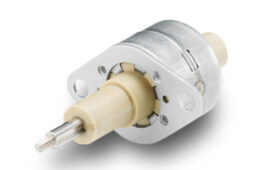Testing thrombogenicity of a heart valve has always required an in vivo assessment. The in vitro blood loop offers a less expensive, faster option of thrombogenicity testing for valves through the use of custom 3D-printed chambers.
Mark Smith, American Preclinical Services

(Image courtesy of American Preclinical Services)
Many specialty medical devices, such as mapping catheters, large-vessel stent grafts, intravascular pumps (LVADS), endovascular grafts and artificial valves are destined for deployment within the patient’s vasculature in a flowing blood path.
Device regulators need to be assured that neither the surface characteristics nor the device materials could cause inappropriate interactions with blood. Therefore, a critical part of the regulatory submission for market approval of these devices will be an assessment of thrombogenicity — assessing for surface- or materials-mediated activation of circulating platelets or components of the blood-clotting cascade that may result in thrombus formation and pose a risk to patient safety.
Although these complex and bulky devices may be single-use, such as a mapping catheter, or permanent implantables such as stent grafts or valves, the hemocompatibility testing in all cases will require a stringent assessment of thrombogenicity as stipulated in Table 1 of ISO 10993-4 Biological evaluation of medical devices – Part 4: Selection of Tests for Interactions with Blood.
These assessments require the device to be deployed in a testable configuration in flowing blood (either in vitro or in vivo), mimicking the expected deployment in the patient. Traditional testing for long and thin catheter-shaped devices, typically < 18 Fr (< 6 mm in diameter), can easily be performed in acute studies in dogs, pigs or sheep. Alternatively, the use of off-the-shelf hemocompatible tubing using in vitro circulating blood loop systems also has shown to be suitable for testing these standard devices of simple design.
However, the larger and more complex devices we have described here — larger stents, grafts, thrombus-capture structures, valves or pumps — are simply not suitable for deployment in any easily accessible site in large animal anatomy without substantial surgical or interventional support. In addition, the devices are simply too large and cannot be deployed in a section of tubing simulating a flowing blood path in a blood-loop model.
These types of devices are, however, well-suited for a newer alternative in the in vitro testing models. This includes the design and production of customizable blood flow chambers that can somewhat mimic the clinical deployment of the device and allow suitable blood flow to perform a thrombogenicity assessment after the requisite four-hour dwell time. This test duration is consistent with the ISO guidance, and even though some devices may be deployed for shorter periods, assessing in these test systems for the standard duration of four hours is recommended. Predicate devices should also be used in either the same or a similarly customized chamber.
Making custom-designed chambers for this type of testing sounds expensive, but 3D-printing them with suitable materials and surface coatings is ideal for assessing the thrombogenicity of complex devices and eventually obtaining a key component of the blood compatibility safety indications required for approval. If new design changes arise, or any manufacturing materials changes are required, the same chamber configuration can be reused for early confirmation of materials’ suitability or surface change in a non-GLP feasibility assessment. Alternatively, the same chambers can be used in the confirmative GLP studies, which are often required for significant material or design changes.
The steps to obtain a suitable chamber design are easy. First, confirm the need with your testing lab that the overall size or design of the device to be tested is not compatible with testing in a standard blood loop system (typical of valves, stent-grafts or other complex devices). Second, research the required chamber shape and size that will allow deployment of the device into a configuration that will mimic the use in a patient. Finally, design the chamber with the minimum total volume to optimize blood utilization, allow suitable blood flow, eliminate direct contact of the deployed device with the chamber walls, and with a flow path shape selected that will minimize the potential for turbulent flow.
Once a suitable chamber design has been achieved, the testing can proceed as in a typical blood-loop model with the chamber inserted into the blood flow path. Select an appropriate predicate device (a legally marketed comparator device) that will also fit in the chamber or design a similar size and shape chamber for the predicate. Then, proceed with the side-by-side evaluation using thrombus surface quantification techniques specified in the ISO 10993-4 guideline.
Overall, this sounds like a complicated and expensive undertaking in the required panel of testing for this family of complex design devices, but with good planning and some additional work from your own design/engineering team, access to a good 3D printing shop and a reputable testing laboratory, the path to successful testing can be achieved.
Mark Smith has been involved in medical device evaluation for the past 15 years. He is a newly semi-retired co-founder of American Preclinical Services in Minneapolis and is currently serving as a consultant to APS and their clients in medical device testing design and regulatory follow-up.
The opinions expressed in this blog post are the author’s only and do not necessarily reflect those of Medical Design and Outsourcing or its employees.




